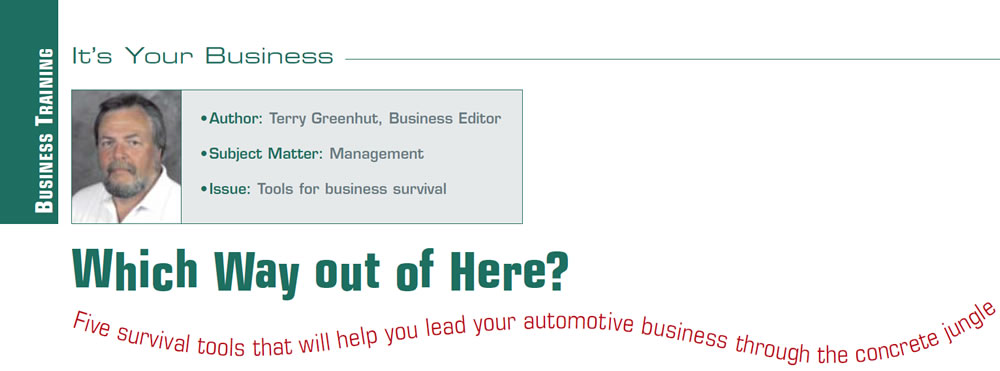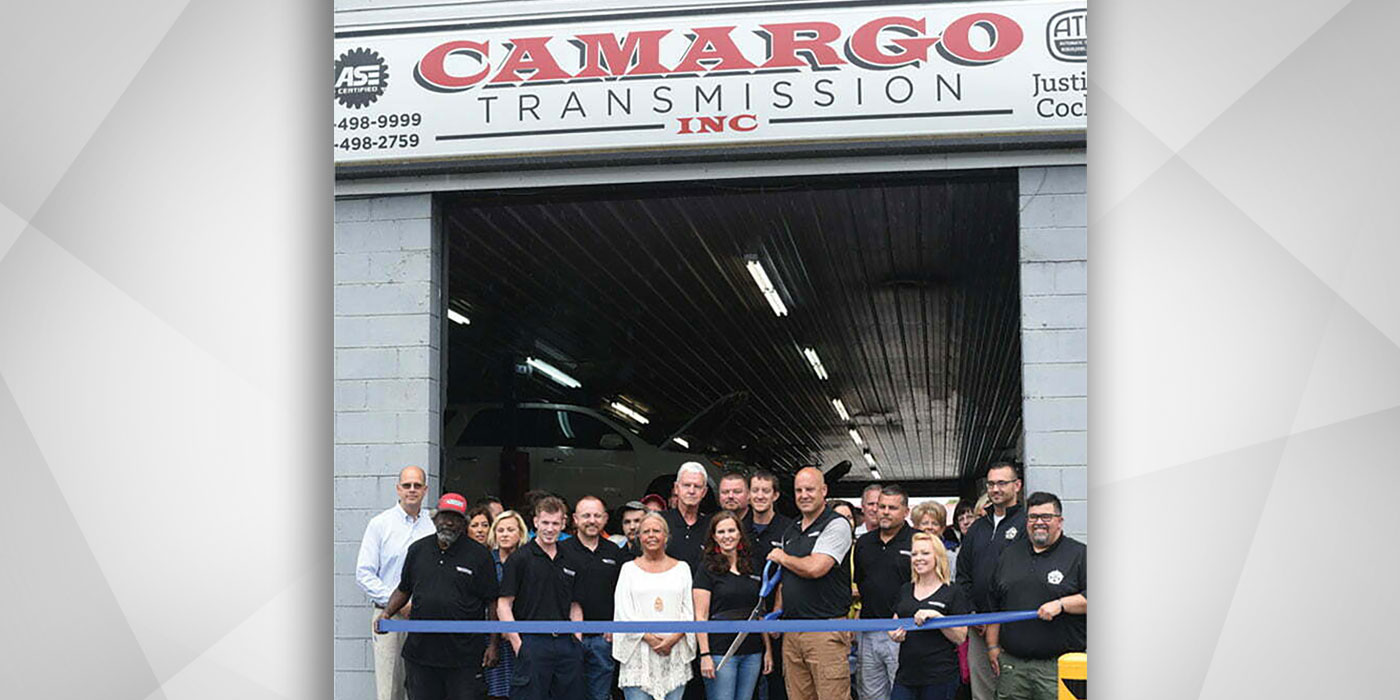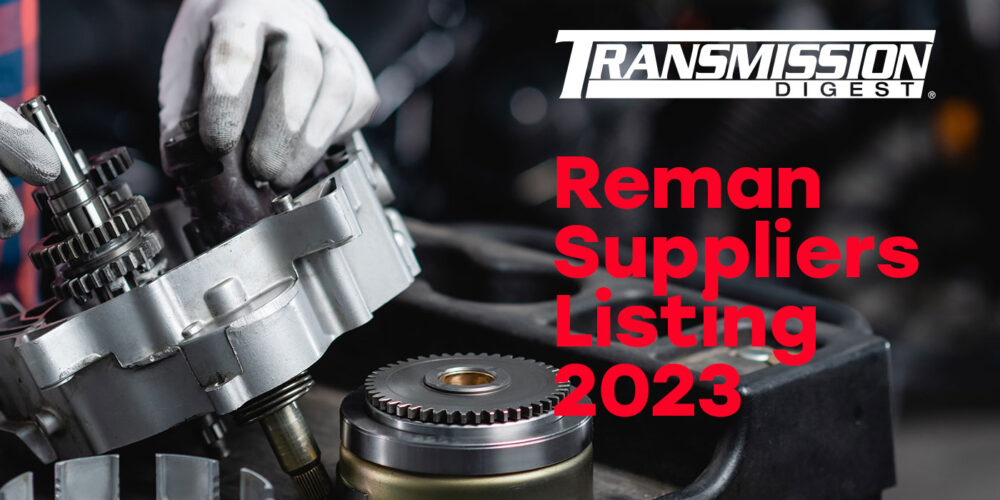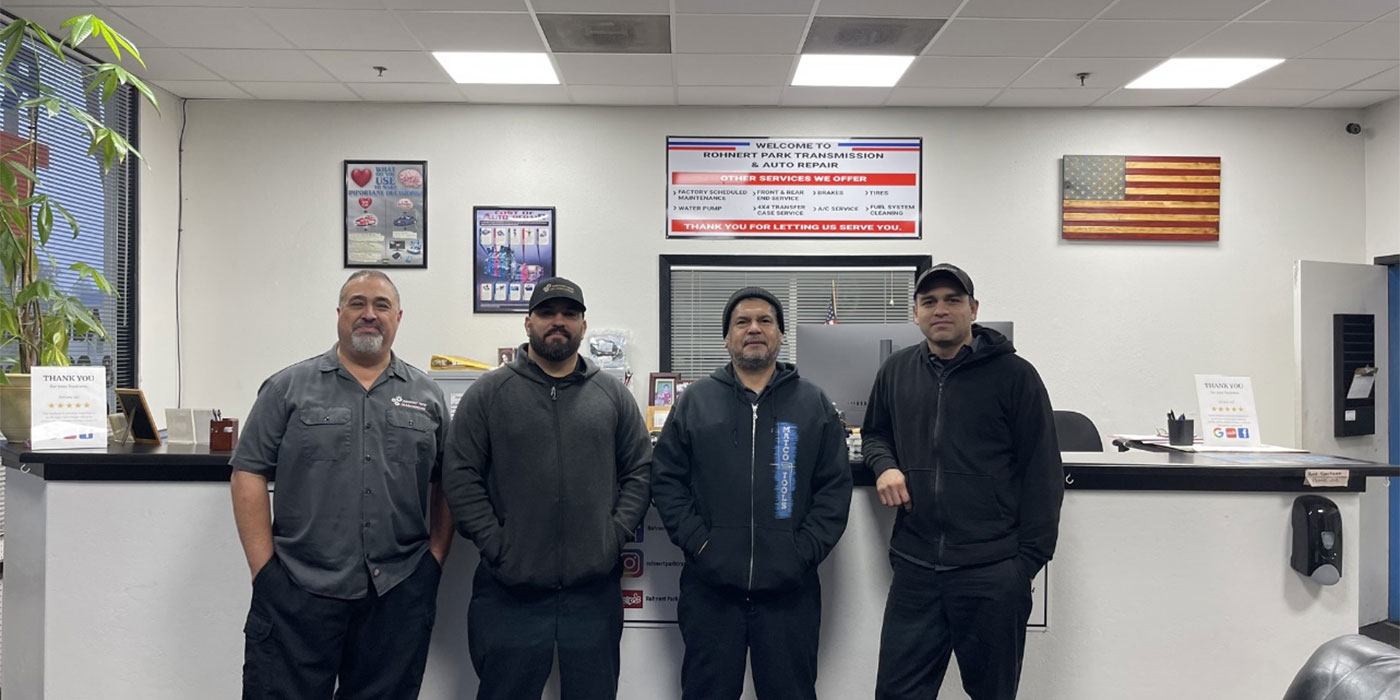
It’s Your Business
- Author: Terry Greenhut, Business Editor
- Subject Matter: Management
- Issue: Tools for business survival
Five survival tools that will help you lead your automotive business through the concrete jungle
Odds are you’ve watched one of television’s many popular survival reality shows. You know the type: A group of people are dropped into the wilderness far from civilization with only the clothes on their backs and perhaps a few other items. Then, it’s up to them to choose a leader to help them survive until they can reach safety or their time limit is up. Along the way, viewers are amazed by the tools they fashion to make survival possible: A fire-starting bow drill made of sticks, a fishing line made of shoelaces and a thorn, a water container made from a cactus or gourd, a frying pan made from a rock, and shelters made from trees, leaves and vines or even snow, just to name a few.
So, what on earth do automotive-shop owners and managers have in common with these enterprising survival-show challengers?
As a leader, which is what you must be or become, it can often feel as if you’ve been dropped in the middle of an inhospitable environment (better known as the rat race of everyday business survival) with a similar lack of ready-made tools, and as an added challenge you must get not only yourself but also your whole crew to safety. The good news is that a few simple tools will help you create a map that will successfully guide your shop through the concrete and asphalt jungle.
Just like in a real jungle there are different types of leaders who do well managing the everyday challenges that their tribe, team or group must face. Two types come to mind because they exhibit leadership qualities of both breeds. Zebra and Cheetah leaders are so called because like zebras, they boast a distinctive appearance that others can easily recognize. Like cheetahs, they possess great speed and are particularly quick accelerators; and like both, they have an ability to use their senses so well that they excel in adapting to their environments. In other words, these are leaders who are able to survive and thrive in the fast-paced, always-changing and highly competitive automotive-business world.
It’s important to realize, though, that just being an engaging, adaptable, forward-thinking person isn’t going to persuade either your crew or your customers to follow you. To lead your followers through the concrete jungle you must show them that you not only have the tools to survive but that you also have a map and know how to read and use it.

Here are five essential map-making tools that will help you to navigate and survive in the auto-care wilderness and lead your extended family to safety and success:
Equip your employees with focus and emotion. When your crew is trekking through the jungle, everyone must share a focus. A focus is more than just what your company does or the outcomes it wants to achieve; it’s what drives you, what your core purpose is – your mission statement, if you will – and what you’re passionate about. Without that leadership focus crew members will jump from one thing to another, seldom (if ever) being truly productive. Although their intentions may be as good as gold, a lack of understanding and/or unity in their efforts (as well as a lack of a common passion) will lead to scattered results at best.
Here’s an example of what infusing your crew with focus and emotion looks like in action. A Zebra and Cheetah leader will roll out activities that keep the focus. Let’s say that one activity is to be the friendliest and most customer-oriented automotive-service provider in the area.
The Z & C leader might hold Monday-morning meetings focused on different ways to handle different types of customers and situations. There may be role playing to get everyone involved and prove to them that they are capable of handling any customer situation to a great outcome. Such activities force crew members out of their comfort zone, expanding their self-worth and value to the company. On Wednesdays, at lunch time, the leader could provide an educational program focused on a sales, technical or possibly quality-control issue. Friday evenings, just before quitting time, he or she might do an autopsy of what worked and what didn’t that week. This activity might make the crew think about what they might be able to do next week to make it better. Having small celebrations when goals are met does a lot to keep the crew focused and motivated as well. Bringing in a couple of pizzas for the Friday meeting to thank the crew for a good week is a great morale booster.
Empower with excellence through good goal-setting. We live in a goal-obsessed society. So why, then, do we end up lowering so many of those goals – or not achieving them at all? The reason is simple: Randomly set goals rarely work because they don’t have emotional staying power. In other words, our follow-through is vulnerable to external variables, moods or momentary circumstances.
Good goals have five components: They should be clear, specific, measurable, attainable and linked to your company’s mission. Everyone must know what they are expected to achieve, that they have the tools, that the goals can reasonably be attained, that their progress is being monitored and that the goals are meaningful. If the employee wonders why he or she is doing something, the result may not be favorable. They need to know why to give them purpose. Clear, specific, measurable goals work because we can break them down into quarterly, monthly, weekly and daily increments of progress.
Create the scoreboard. The simple fact is, people play harder when there’s a scoreboard, when eventually a clear winner will emerge. You can build an organizational scoreboard using these guidelines:
- Determine past performances (What did each person do over the past 12-month cycle?)
- Identify variables (How much growth is possible for each person to achieve in her/his specific area of expertise?)
- Estimate future capacity (How much do you want each person to realistically stretch herself/himself over the next cycle?)
- Determine high-value activities (What things must each person do to achieve her/his future capacity? What is a wise use of time and what isn’t? A wise use of time for a rebuilder might be to completely disassemble, inspect, clean and reassemble every valve body. It may take an hour longer but save several 10-hour comebacks and unhappy customers.)
- Determine the scorekeeping method (How will each person measure, record and report their progress?)
When you set up your scoreboard, be sure to clearly reassure your crew that they are not competing against one another because how could they if they are performing different types of jobs; instead, remind them that they’re competing against their own potentials. This will spawn positive peer pressure instead of cutthroat competition and will also make sure that low performers are no longer able to hide in the middle of the pack, taking valuable resources but not contributing to the company’s survival and growth.
Coach ’em up. If the low performers your scoreboard helps you to identify won’t or can’t improve, it’s a Z & C leader’s responsibility to help them up or sometimes out of the company. Although it is never easy, at some point – when all the coaching and training have been exhausted – if they still can’t turn in a reasonable amount of work, they have to go for the sake of the company and all its other employees. Your time and energy will be best spent on helping the mediocre to become good and the good to become great.
This isn’t only about providing continuing education and teaching technical skills, though those things certainly are components of coaching up. Leaders must compensate crew members fairly, let them know it’s safe to be creative and innovative, treat them kindly and assure them that their work is making a positive impact as well as building a legacy of which they can be proud. When all these areas are being addressed satisfactorily, you’ll have built a crew in which everyone is passionate, motivated and productive.
Throw in thunderbolts. Newsflash: People aren’t robots. Yes, your crew might be excited once they see how quickly and effectively you’re moving through the concrete jungle, but eventually their enthusiasm will reach a lull. Even though they may be committed to your company’s mission, many of your people simply aren’t accustomed to producing at high levels for prolonged periods. That’s why Z & C leaders keep their crews fresh by throwing thunderbolts: unexpected jolts to the group that renew energy or pull everyone out of the doldrums.
Thunderbolts might take the form of an unexpected but dynamic guest speaker, taking the crew to a race or car show, throwing a company barbecue or giving an unexpected bonus. Weariness and complacency tend to creep in around the third or fourth month of every cycle. Just make sure you’re throwing thunderbolts in to stir emotions and stoke energy.
Yes, the concrete and asphalt jungle can be a scary place, but not an insurmountable one. Conditions will change, but if you have good basic leadership skills that are consistent your crew will want to follow you through the jungle to achieve the ultimate goal.
We live in a goal-obsessed society.
If the employee wonders why he or she is doing something, the result may not be favorable.














